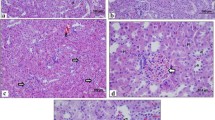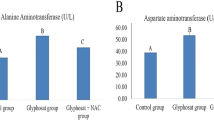Abstract
The present study aimed at investigating the effect of carvacrol on hepatic mitochondrial enzyme activities and DNA damage in d-galactosamine (d-GalN)-induced hepatotoxicity in male albino Wistar rats. The activities of hepatic mitochondrial enzymes such as isocitrate dehydrogenase, α-ketoglutarate dehydrogenase, succinate dehydrogenase, malate dehydrogenase, NADPH dehydrogenase and cytochrome c oxidase significantly decreased in d-GalN-hepatotoxic rats, and administration of carvacrol brought these parameters towards normality. In d-GalN-hepatotoxic rats, the hepatic mitochondrial concentration of thiobarbituric acid reactive substances significantly increased, and administration of carvacrol significantly reduced them towards normality. Furthermore, the activities of enzymatic antioxidants such as superoxide dismutase and glutathione peroxidase and the levels of non-enzymatic antioxidants such as vitamin C, vitamin E and reduced glutathione decreased significantly in the liver mitochondria. Administration of carvacrol returned the enzymatic and non-enzymatic antioxidants towards normality. d-GalN-hepatotoxic rats had increased DNA damage, which administration of carvacrol significantly decreased. These results suggest that carvacrol has liver mitochondrial antioxidant properties and possesses a defensive effect against mitochondrial enzymes and DNA damage in d-GalN-induced rats.


Similar content being viewed by others
References
Hwang JM, Tseng TH, Tsai YY, Lee HJ, Chou FP, Wang CJ, Chu CY (2005) Protective effects of baicalein on tert-butyl hydroperoxide-induced hepatic toxicity in rat hepatocytes. J Biomed Sci 12:389–397
Decker K, Keppler D (1972) Galactosamine induced liver injury. In: Popper H, Schaffner F (eds) Progress in liver disease, vol 4. Grune and Stratton, New York, pp 183–199
Sakaguchi S, Yokota K (1995) Role of Ca2+ on endotoxin-sensitivity by galactosamine challenge: lipid peroxide formation and hepatotoxicity in zymosan primed mice. Pharmacol Toxicol 77:81–86
Luft R (1995) The development of mitochondrial medicine. Biochim Biophys Acta 1271:1–6
Luft R, Landau BR (1995) Mitochondrial medicine. J Intern Med 238:405–421
Wallace DC (1992) Mitochondrial genetics: a paradigm for aging and degenerative diseases. Science 256:628–632
Zargari A (1990) Medicinal plants, 4th edn. Tehran University Publications, Tehran, pp 42–45
Kirimer N, Baser KHC, Tumen G (1995) Carvacrol rich plants in Turkey. Chem Nat Compd 31:37–42
Lagouri V, Bleskas G, Tsimidou M, Kokkini S, Boskou D (1993) Composition and antioxidant activity of essential oils from oregano plants grown wild in Greece. Z Lebens Unter und Fors 197:20–23
Fenaroli G (2002) Fenaroli’s handbook of flavor ingredients, 4th edn. CRC Press, Boca Raton
Aristatile B, Al-Numair KS, Veeramani C, Pugalendi KV (2009) Effect of carvacrol on hepatic marker enzymes and antioxidant status in d-galactosamine induced-hepatotoxicity in rats. Fundam Clin Pharmacol 23:757–765
Hajhashemi V, Ghannadi A, Pezeshkian SK (2002) Antinociceptive and anti-inflammatory effects of Satureja hortensis L. extracts and essential oil. J Ethnopharmacol 82:83–87
Yanishlieva NV, Marinova E, Gordon MH, Reneva VG (1999) Antioxidant activity and mechanism of action of thymol and carvacrol in two lipid systems. Food Chem 64:59–66
Evangelou G, Karkaponnas KS, Liasko R, Nonni A, Stefanou D, Kallistratos G (1997) Dose-related preventive and therapeutic effects of antioxidants–anticarcinogenesis on experimentally induced malignant tumors in Wistar rats. Cancer Lett 115:101–105
Shelef LA (1983) Antimicrobial effects of spices. J Food Saf 6:29–44
Aligiannis N, Kalpoutzakis E, Mitaki S, Chinou IB (2001) Composition and antimicrobial activity of the essential oil of two Organum species. J Agric Food Chem 49:4168–4170
Sokmen W, Serkedjieva J, Daferera D, Gulluce M, Polissiou M, Tepe B, Akpular HA, Sahin Sokmen FA (2004) In vitro antioxidant, antimicrobial and antiviral activities of the essential oil and various extracts from herbal parts and callus cultures of Origanum acutidens. J Agric Food Chem 52:3309–3312
Knowles JR, Roller S (2001) Efficacy of chitosan, carvacrol and a hydrogen peroxide-based biocide against food borne microorganisms in suspension and adhered to stainless steel. J Food Prot 64:1542–1548
Knowles JR, Roller S, Murray DB, Naidu AS (2005) Antimicrobial action of carvacrol at different stages of dual-species biofilm development by Staphylococcus aureus and Salmonella typhimurium. Appl Environ Microbiol 71:797–803
Johnson D, Lardy H (1981) Isolation of liver or kidney mitochondria. In: Methods in enzymology. Academic Press, London, pp 94–96
Bell JL, Baron DN (1960) A colorimetric method for determination of isocitrate dehydrogenase. Clin Chem Acta 5:740–747
Reed LJ, Mukherjee RB (1969) α-Ketoglutarate dehydrogenase complex from Escherichia coli. In: Colowick SP, Kaplon NO (eds) Methods in enzymology, vol 13. Academic Press, New York, pp 53–61
Slater EC, Bonner WDJ (1952) The effect of fluoride on succinic oxidase system. Biochemistry 52:185–195
Mehler AH, Kornberg A, Grisolia S, Ochoa S (1948) The enzymatic mechanism of oxidation-reductions between malate or isocitrate and pyruvate. J Biol Chem 174:961–977
Pearl W, Cascarano J, Zweifach BW (1963) Microdetermination of cytochrome oxidase in rat tissues by the oxidation of N-phenyl-p-phenylene diamine or ascorbic acid. J Histochem Cytochem 2:102–104
Minakami S, Ringler RL, Singer TP (1962) Studies on the respiratory chain-linked dihydrodiphosphopyridine nucleotide dehydrogenase. I. Assay of the enzyme in particulate and in soluble preparation. J Biol Chem 237:569–576
Niehaus WG, Samuelson B (1968) Formation of malondialdehyde from phospholipid arachidonate during microsomal lipid peroxidation. Eur J Biochem 6:126–130
Kakkar P, Das B, Viswanathan PN (1984) A modified spectrophotometric assay of superoxide dismutase (SOD). Ind J Biochem Biophys 21:130–132
Rotruck JJ, Pope AL, Ganther HE, Swanson AB (1973) Selenium: biochemical rates as a component of glutathione peroxidase. Science 179:588–590
Ellman GL (1959) Tissue sulphydryl groups. Arch Biochem Biophys 82:70–77
Roe JH, Kuether CA (1943) The determination of ascorbic acid in whole blood and urine through the 2,4-dinitrophenylhydrazine derivative of dehydroascorbic acid. J Biol Chem 11:145–164
Baker H, Frank O, De Angelis B, Feingold S (1980) Plasma tocopherol in man at various times after ingesting free or acetylated tocopherol. Nutr Rep Int 21:531–536
Boyum A (1968) Isolation of mononuclear cells and granulocytes from human blood. Sci J Clin Lab Invest 21(97):77–89
Santhosh A, Mathew S, Sudhakaran PR (1996) Synthesis of sulphated proteoglycans by primary cultures of rat hepatocyte modulation by matrix substratum. Mol Cell Biochem 165(1):1–7
Singh NP, McCoy MT, Schneider EL (1988) A simple technique for quantization of low levels of DNA damage in individual cells. Exp Cell Res 175(1):184–191
Keppler D, Lesch R, Reutter W, Decker K (1968) Experimental hepatitis induced by d-galactosamine. Exp Mol Pathol 9:279–290
Decker K, Keppler D (1972) Galactosamine-induced liver injury. In: Popper H, Schaffner F (eds) Progress in liver disease, vol 4. Grune and Stratton, New York, pp 183–196
Martin P, Friedman LS (1992) Assessment of liver function and diagnostic studies. In: Friedman LS, Keeffe EB (eds) Handbook of liver disease. Churchill Livingstone, Philadelphia, pp 1–14
Bailey SM, Cunningham CC (2002) Contribution of mitochondria to oxidative stress associated with alcoholic liver disease. Free Radic Biol Med 32(1):11–16
Puzziferri L, Signorile A, Guerrieri F, Papa S, Cuomo V, Steardo L (2000) Chronic low dose ethanol intake: biochemical characterization of liver mitochondria in rats. Life Sci 66(6):477–484
Schrauwen P, Hesselink MKC (2004) Oxidative capacity, lipotoxicity, and mitochondrial damage in type 2 diabetes. Diabetes 53:1412–1417
Enns GM (2003) The contribution of mitochondria to common disorders. Mol Genet Metab 80:11–26
Shigenaga MK, Hagen TM, Ames BN (1994) Oxidative damage and mitochondrial decay in aging. Proc Natl Acad Sci USA 91(23):10771–10778
Gao J, Tang X, Dou H, Fan Y, Zhao X, Xu Q (2004) Hepatoprotective activity of Terminalia catappa L. leaves and its two triterpenoids. J Pharm Pharmacol 56(11):1449–1455
Fernandez-Checa JC, Kaplowitz N, Garcia Ruiz C, Colell A, Miranda M, Mari M, Ardite E, Morales A (1997) GSH transport in mitochondria: defense against TNF-induced oxidative stress and alcohol-induced defect. Am J Physiol 273:G7–G17
Andersson BS, Rundgren M, Nelson SD, Harder S (1990) N-Acetyl-p-benzoquinone imine-induced changes in the energy metabolism in hepatocytes. Chem Biol Interact 75:201–211
Aeschbach R, Loliger J, Scott BC, Murcia A, Butler J, Halliwell B, Aruoma OI (1994) Antioxidant actions of thymol, carvacrol, 6-gingerol, zingerone and hydroxytyrosol. Food Chem Toxicol 32:31–36
Blasiak J, Kowalik J (2001) Protective action of vitamin C against DNA damage induced by selenium-cisplatin conjugate. Acta Biochim Pol 48:233–240
Aristatile B, Al-Numair KS, Veeramani C (2010) Protective effect of carvacrol on oxidative stress and cellular DNA damage induced by UVB irradiation in human peripheral lymphocytes. J Biochem Mol Toxicol (in press). DOI: 10.1002/jbt.20355
Yu TW, Anderson D (1997) Reactive oxygen species-induced DNA damage and its modification: a chemical investigation. Mutat Res 379:201–210
Conflict of interest
The authors report no conflict of interest. The authors alone are responsible for the content and writing of the paper.
Author information
Authors and Affiliations
Corresponding author
Rights and permissions
About this article
Cite this article
Aristatile, B., Al-Numair, K.S., Al-Assaf, A.H. et al. Pharmacological effect of carvacrol on d-galactosamine-induced mitochondrial enzymes and DNA damage by single-cell gel electrophoresis. J Nat Med 65, 568–577 (2011). https://doi.org/10.1007/s11418-011-0544-8
Received:
Accepted:
Published:
Issue Date:
DOI: https://doi.org/10.1007/s11418-011-0544-8




